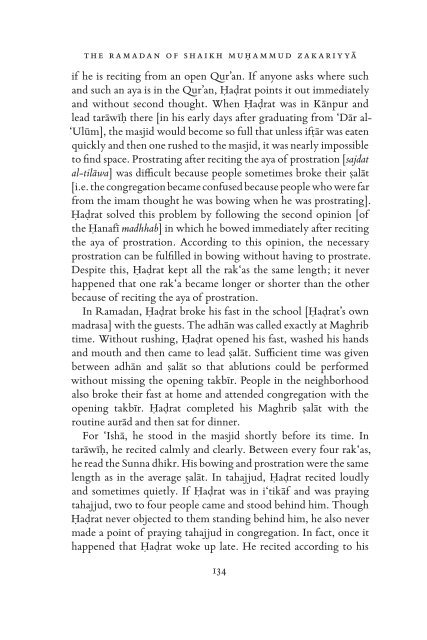TheRamadanOfShaykhAl-hadithMuhammadZakariyyaKandhelviAndOurEldersByShaykhDrMuhammadIsmailMemonMadani
TheRamadanOfShaykhAl-hadithMuhammadZakariyyaKandhelviAndOurEldersByShaykhDrMuhammadIsmailMemonMadani
TheRamadanOfShaykhAl-hadithMuhammadZakariyyaKandhelviAndOurEldersByShaykhDrMuhammadIsmailMemonMadani
Create successful ePaper yourself
Turn your PDF publications into a flip-book with our unique Google optimized e-Paper software.
the ramadan of shaikh muĤ ammud zakariyyĀif he is reciting from an open Qur’an. If anyone asks where suchand such an aya is in the Qur’an, Ĥađrat points it out immediatelyand without second thought. When Ĥađrat was in Kānpur andlead tarāwīĥ there [in his early days after graduating from ‘Dār al-‘Ulūm], the masjid would become so full that unless ifţār was eatenquickly and then one rushed to the masjid, it was nearly impossibleto find space. Prostrating after reciting the aya of prostration [sajdatal-tilāwa] was difficult because people sometimes broke their śalāt[i.e. the congregation became confused because people who were farfrom the imam thought he was bowing when he was prostrating].Ĥađrat solved this problem by following the second opinion [ofthe Ĥanafī madhhab] in which he bowed immediately after recitingthe aya of prostration. According to this opinion, the necessaryprostration can be fulfilled in bowing without having to prostrate.Despite this, Ĥađrat kept all the rak‘as the same length; it neverhappened that one rak‘a became longer or shorter than the otherbecause of reciting the aya of prostration.In Ramadan, Ĥađrat broke his fast in the school [Ĥađrat’s ownmadrasa] with the guests. The adhān was called exactly at Maghribtime. Without rushing, Ĥađrat opened his fast, washed his handsand mouth and then came to lead śalāt. Sufficient time was givenbetween adhān and śalāt so that ablutions could be performedwithout missing the opening takbīr. People in the neighborhoodalso broke their fast at home and attended congregation with theopening takbīr. Ĥađrat completed his Maghrib śalāt with theroutine aurād and then sat for dinner.For ‘Ishā, he stood in the masjid shortly before its time. Intarāwīĥ, he recited calmly and clearly. Between every four rak‘as,he read the Sunna dhikr. His bowing and prostration were the samelength as in the average śalāt. In tahajjud, Ĥađrat recited loudlyand sometimes quietly. If Ĥađrat was in i‘tikāf and was prayingtahajjud, two to four people came and stood behind him. ThoughĤađrat never objected to them standing behind him, he also nevermade a point of praying tahajjud in congregation. In fact, once ithappened that Ĥađrat woke up late. He recited according to his134


